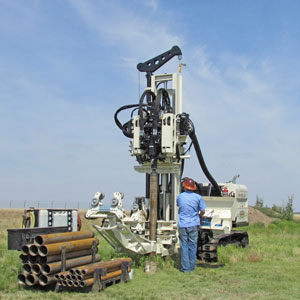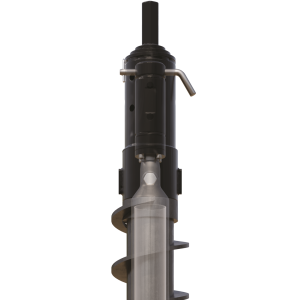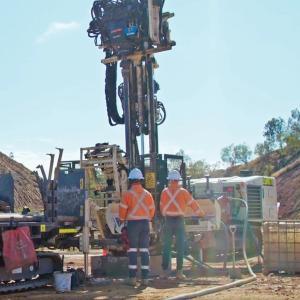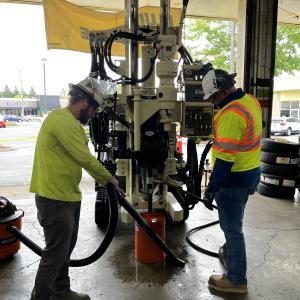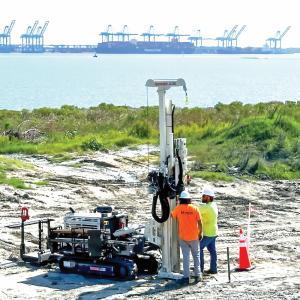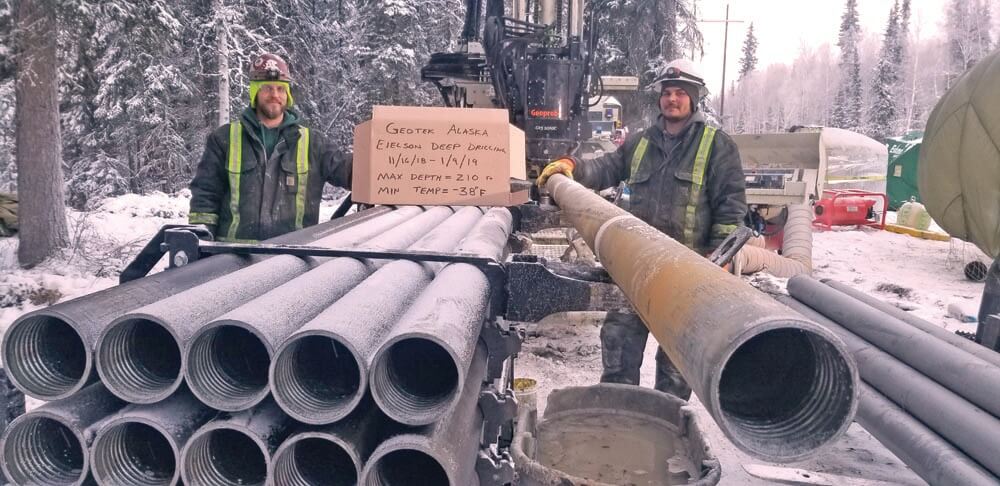
Geoprobe® sonic drilling vs rotary drilling proves profitable technology in Alaska. L to R: Travis Drewry and Steve Simas.
GEOTEK ALASKA began with a 54DT and environmental drilling as their bread and butter. Through the years the Alaska company has diversified by opening a second location — in Hawaii — and completing a 50/50 mix of environmental and geotechnical drilling. As the company has grown, they’ve sought opportunities to grow the technologies offered to clients — including sonic drilling.
"We initially rented an 8150LS for a job on an Air Force base in Fairbanks, drilling 2-inch wells to 220 feet from December through January in -30 degree weather,” Vojta said. “The 8150LS performed flawlessly in those temperatures. We had more problems with trucks and skidsteers then we did the 8150.”
The crew sampled and set a well to 220 feet in a single shift then a second crew performed the surface completions and site preps.
“It was our first sonic project and it went well and completed under budget, and this was all possible because of the durability of the 8150 and the tooling,” Scott Vojta, president, said.
They wanted to purchase the rig then but were hesitant to spend that amount of money on a technology yet to be proven profitable in Alaska. But when Geoprobe® had an 8140LC in on trade, Vojta seized the opportunity to invest in sonic technology and understand where in their region sonic drilling vs rotary drilling made economic sense.
“For the soils in Fairbanks, it’s conducive to use sonic to get to depth. If rotary drilling auger, you potentially break your tool string or are not able to get cuttings to return to the surface and stall out. Direct push using an 8040 will meet refusal before depth is achieved. Thus you have to use a tricone bit to rotary wash and develop large amounts of investigation derived waste (IDW),” Vojta said. “Sonic technology can sample and set a well to 200 feet in a day. It’s extremely fast and collects a large sample. If you do the water correctly, there’s not a lot of IDW compared to rotary method.”
As they’ve been establishing their sonic footprint, they’ve come to realize sonic drilling vs rotary drilling or direct push can reduce the dollar per foot.
“Some people think sonic costs more to run, but cost wise per foot — when it works, it’s less,” Vojta said. “We’re building a solid foundation of where it will work and clients like it. Our piece of the pie is growing.”
He admits clients are curious but slow to warm to the new technology.
“Alaska is a big state with many soil types. Clients wrestle with proven drilling methods versus newer technology, but we are building their confidence level every day,” Vojta said. “Every client has been happy it has met the scope of work. People have confidence in running the technology if we tell them the project is a good option for sonic.”
They’ve been pleased with the rig’s reliability as they’ve worked to grow their sector.
“The durability of the rig has been great. We’ve had very few issues in the field,” Vojta said.
That durability extends to the Geoprobe® sonic tooling they run on the rig. They’ve primarily utilized the tried-and-true 4X6 sampling method, but recently purchased 6X8.
“Nothing touches Geoprobe® tooling — from the thread design, to the rod thickness, to the durability and the good price. Any drill rod we use, we use Geoprobe®,” Vojta said. “We’ve had a very low failure rate with few issues in the field. It’s extremely durable and runs great.”
Contact Us
1835 Wall Street
Salina, Kansas 67401
Phone: (785) 825-1842
Related Articles
Geoprobe® Introduces Drill Rig Telemetry to the Drilling Industry — monitor rig operations easily through our customer portal, Centerpoint Connected.
ID: 14625 | Date:
The 4.25 HSA Continuous Sampler is versatile and easy to use when collecting large sample volumes.
ID: 14619 | Date:
The 8150LS fits inside a 40-ft. shipping container - perfect for overseas shipment.
ID: 14616 | Date:
6011DT’s compact design and GH63 hammer let you reach depth in tight-access sites.
ID: 14615 | Date:
6712DT delivers the power and agility needed for injection point projects.
ID: 14614 | Date:


